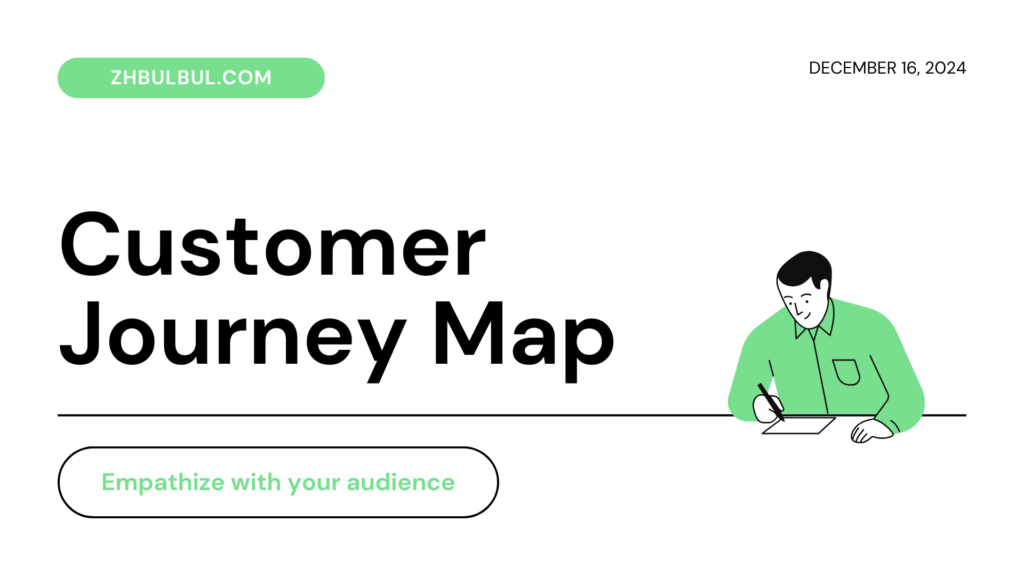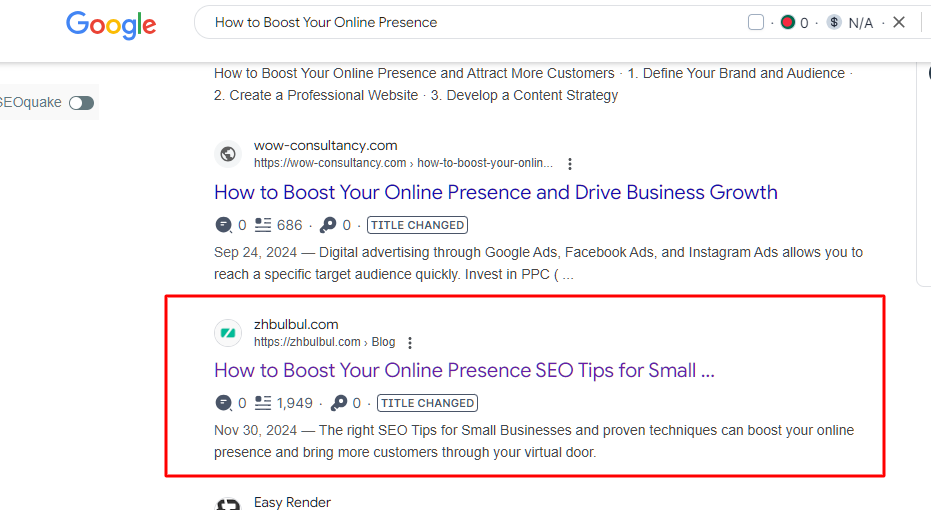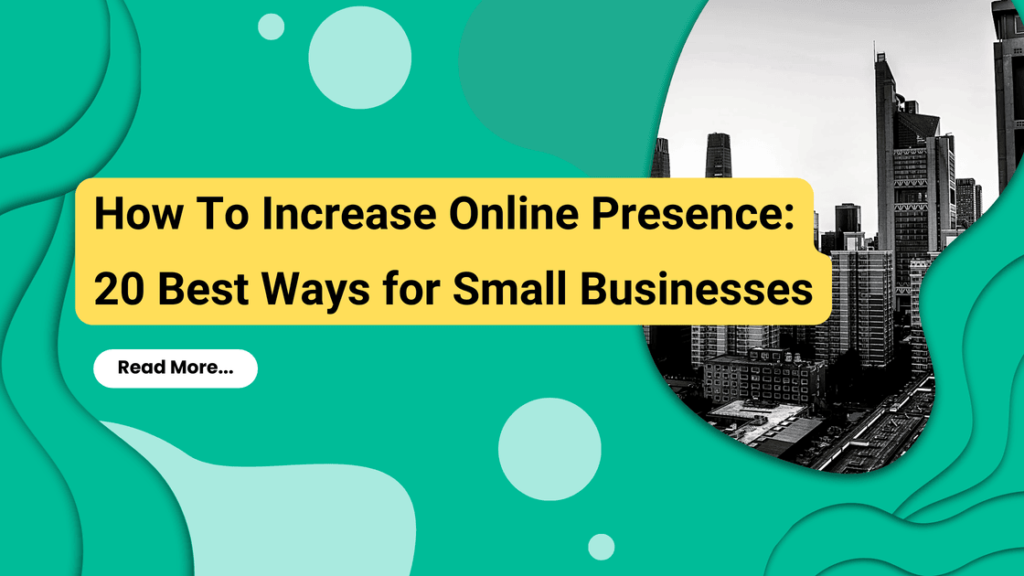How to increase online presence? Have you ever imagined how much a strong online presence could help your small business? It’s more important than your realization. Let’s dive into it. We will explore why it matters for you and how it can make a positive impact on you. To increase your online presence, you have to apply a digital marketing strategy.
Understanding How to Increase Online Presence: Building Your Digital Landscape
Think a customer is searching online for a product or service. And, the exact service you are offering online. Do they find your business instantly, or do they just scroll past, unaware of your existence and business? Your online presence management ensures people can find you easily.
It goes beyond creating a website, social media profile or social media presence. You make yourself easily discoverable and approachable across digital platforms like social media platforms. Here, content marketing plays a key role in ensuring your business is easily discoverable and engaging with potential customer online.
Your online presence management is like a bond for your business. A strong presence helps customers find you when they need you. Your website, social media presence, and reviews make it simple for people to connect with your brand.
A glowing Yelp review or a helpful blog post on your website creates a lasting impression with every interaction. And together, these marks form the digital footprint of your small business.
Why Your Online Presence Matters in Building Connections and Growing Your Business
Let’s think about it, someone is searching online and finds your business. Maybe it’s through a Google search or an Instagram ad.
They become interested, check out your website, and finally, they’re making a purchase from you or booking for your service. This is called the power of stronger online presence.
It helps you generate new customers and keeps them coming back frequently to you. And, you need to create a customer journey map.

When you actively show up online, you’re not just selling products or services. You’re building trust and forming connections.
Customers see you answering their questions on social media, sharing useful tips in your blog, or sending thoughtful emails about your latest offers. They feel like they know you, and that keeps them loyal.
And it doesn’t stop there. A well-executed online presence grows your business. You attract leads, increase your reach, and strengthen your reputation.
Each post, ad, or review adds to your story, helping more people discover and trust your brand. When you invest in your online presence, you don’t just boost visibility—you build a community that fuels your success.
20 Best Ways to Improve Your Website for a Stronger Online Presence
1. Create a stunning Professional look and a User-Friendly Website
Think about a potential customer landing on your website. Within a few seconds, visitors decide whether they will stay on or leave your website.
Here comes the power of your website’s attention-grabbing design and content. Your website can hold and retain the customer for a longer period.
A professional, user-friendly website is your first encounter with your potential customer, and it should create a great impression at first.

Start by keeping your design clean and simple. Visitors should instantly understand what you offer. Use clear navigation menus to guide them to key pages like your services, contact information, or an FAQ section.
Don’t forget about mobile users—ensure your site looks and works beautifully on all devices.
Loading speed matters too. If your website takes more than 3 seconds to load, your potential visitors may go away.
By optimizing the speed and functionality of your site, you can create a positive experience. It builds trust and keeps customers coming back to your website.
2. Implement SEO (Search Engine Optimization) Best Practices
Have you ever gone through the experience of looking for something online and wondering what brought certain websites to the top? That’s SEO at work.
Proper SEO (search engine optimization) techniques can optimize your website and bring it to a high ranking in the search engine result pages (SERPs) of any search engine, including Google, Bing, and many more. If you are running a local business, you can implement a local SEO strategy. Thus, you can generate huge traffic on your site.

Start with keyword research with the help of an SEO (search engine optimization) Expert or by yourself. Suppose your customers are searching for something by using keywords.
It is now your responsibility to use those keywords naturally inside your page titles, headers, and content. For example, should you own a bakery, you might like to target phrases such as “best cupcakes near me” or “wedding cake delivery” to make finding you easy.
SEO is not only about words; there is a structure to it. Meta descriptions are the next best thing to tell search engines and users what a page is all about.
Optimize your images with alt text; you also have internal links. The whole aim is to make your website user-friendly from both ends, including that of search engines.

3. Start a Blog to Engage and Inform
It allows you to keep running a conversation with your customers, answering their queries in person and making them know you better without walking into your premises. Blogging has that great power.

Starting a blog gives you a forum to provide very valuable information to your online audiences. Thus, you can improve your online reputation.
To demonstrate, suppose you are a fitness coach. You could be going to write on, let’s say, “5 Quick Workouts for Busy Professionals” or “Benefits of Running for Beginners.”
Such posts would not only benefit your audiences but are also a signal to search engines such as Google, Bing, etc., to validate the relevance and life of your website.
A blog allows you to focus on the specific questions your customers are asking. By providing helpful answers, you establish yourself as an expert they can trust.
Every post you create increases your chances of showing up in search results and bringing more people to your website.
Optimizing Your Social Media for Better Reach
4. Focus on Key Platforms for Your Audience
All social media platforms with social media accounts have distinctive features because they are all different. They do have their roles for small companies. You have to select the right social media channel.
The crucial thing is to find the right platforms that cater because, without them, it all turns out to be a wasted effort.
Then, think about where your customers are usually found online. Are they scrolling through Instagram’s visual feeds or engaging with business discussions on LinkedIn?
Are they looking for quick answers on Twitter or watching tutorials on YouTube?
If, for example, your business is a restaurant, Instagram and Facebook would be great platforms to display appetizing photographs and connect with your local community.
About the B2B services that you offer, consider focusing on LinkedIn to reach possible connections in the professional arena.
Target audience identification would be the first thing you need to do. Then it becomes possible to direct energies and effort at only a few platforms thus strengthening rather than diluting your following engagement.
5. Engage with Followers, Not Just Numbers
If you have followers, that is not what matters, but the engagement they have with your posts is really what matters.
Imagine having a thousand followers and only five of those coming to your status; wouldn’t that be a waste in your eyes?
Aren’t you better off with a crowd of engaged ones? How are you ever going to build that loyalty?
Let yourself be engaged; for example: be very interactive in your comments sections, thank people when they share your posts, and initiate conversations.
Start asking questions in your captions or even in polls in your stories to get feedback. When people feel like they’re being heard, they will be much more open to staying positive and supporting your company.
6. Craft Emotionally Compelling Content & Content Marketing
People connect with brands that evoke emotion. Whether it’s humor, inspiration, or empathy, emotional content is what gets shared.
And sharing is what amplifies your reach. But how do you create well-written SEO-friendly content that connects your audiences?
Start by understanding your audience’s pain points, desires, and passions. What are they expecting from your business or service?
What problems do they want solved? Craft posts that speak directly to those emotions.
A pet shop can narrate a touching story about an adopted dog that got a forever home. Or, a fitness brand could motivate followers with quotes to keep them going despite hard workouts.
Emotionally compelling content grabs attention, but it gets shared, and that is where the reach is going to grow.
In the content market, building your online presence is crucial for small businesses. A strong content marketing strategy, focusing on high-quality content, boosts visibility and engages customers. By consistently contributing to the content market, you can strengthen your brand and establish long-term customer loyalty.
7. Optimize Social Media Content for Search
Look, social media is not only for showing off your good photography skills; it is also a medium that might hold the key to getting selected.
SEO can also be implemented not only in online pages but also through effective search-engine-optimized social media content.
For example, you can begin by inserting your business’s keywords as tags in your posts and captions. Search your brain for keywords your customers might type when looking for your product or service.
Like if you are the owner of a local coffee shop, you may want to hashtag something like #bestcoffee or #coffeeoftheday for a better exposure possibility of your posts.
Do not forget alt text for images as this helps both in terms of SEO and making your content much more accessible.
This increases the likelihood that a new follower will find you by optimizing your posts for search.
8. Maintain Consistent Posting and Engagement
To have a social media presence, consistency is the key. Just posting once a week and hoping for the best is not going to yield any good results.
For such a thing to have an impact, you need to be present constantly with your audience.
Establish a posting calendar tailored to your business and follow it. If that’s once every day, a few times a week, or once a week-consistency keeps your brand top of mind.
You shouldn’t just post but also interact with your followers by liking and commenting on their posts, connecting and engaging other businesses, and having conversations.
The more active you are, the more likely you will stay connected to your audience and nurture stronger bonds.
Boosting Your Visibility with Online Listings and Directories
9. Start with Major Directories and Review Sites
How do you search for a local business? You probably start with Google, Yelp, or other review sites. Now, imagine your business isn’t listed on these platforms. That’d be like hiding your store in a mall where no one would find it.
To boost your visibility, start by getting your business listed on major directories. Google My Business is essential.
This is usually the first stop people go to when looking to search for local businesses. Yelp, Facebook, and other special industry directories are also great for building credibility.
This means that customers have easier access to you, read reviews about you, and may, at some point in time, reach you.
10. Fully Optimize Your Listings
It’s not enough just to list your business. Your profile needs to shine. You have to make sure that every section of your business listing is completed.
Add your opening hours, business address, phone number, and website. Upload clear, high-quality photos of your business and products.
The more details you’ve provided, the more chances that people will trust your company.
This increases your chances of showing up on a local search, and potential customers can see what you offer and how they can get to you without having to guess.
11. Develop a Strong Review Strategy
Reviews are like modern-day word of mouth. When customers look into your business, they often check customer’ reviews first. Positive reviews can put you ahead of competitors.
Encourage happy customers to leave reviews. Make it easy by sending follow-up emails or including a link in your social media posts.
When you get a review, respond! Thank you for your candid thoughts. Any issues brought to light here will be handled extremely diplomatically and tastefully.
Responding to a review is a sign that an organization cares enough to convert a negative experience into a positive and better one.
12. Monitor Listings Regularly
Once your listings are live, don’t just forget about them. You need to monitor them regularly. Make sure your information is up to date, especially if you change business hours or move locations.
Also, check your reviews. Responding quickly shows you’re actively engaged with your customers. If you spot any incorrect information or harmful reviews, take action right away.
Keep your listings fresh and relevant so people can always find the right info when they search for your business.
Using Paid Ads (online advertising) to Drive Traffic and Awareness
13. Google Search Ads for Immediate Traffic
You can run paid advertising like Google Ads for your brand to get instant results. When someone searches for the product you sell, Google leans towards your ad to come up at the top of the page. This is how powerful online ads like Google Ads can be.
Newspapers show these ads to potential buyers who are at the market looking for what you have to offer. Choose keywords that may be searched by your audience.
Next, you could write a simple and clear ad that captures their attention. Say you have a bakery, then a tagline could be something like, “Fresh Baked Goods Delivered Daily – Order Now!”
These advertisements are timed exactly as someone requires the goods or services you would be providing.
14. Leverage social channels like Facebook and Instagram Ads for Brand Awareness
You can run paid advertising, like Facebook ads, for your brand awareness. Imagine your audience who has a social media account, scrolling through Facebook or Instagram. Such advertisements seem as if created for a specific person; much of the magic comes with social media marketing and targeting. You can deploy influencers in your Facebook ads. This is called influencer marketing.
By using age, location, gender, and interests or pages on Facebook and Instagram that someone follows, you can target them all via social media marketing. For instance, run a social media marketing campaign where you offer an example of fitness equipment and direct it to health and wellness enthusiasts.
Layer exciting, colorful visuals and call to a simple action like “Shop Now” or “Learn More.” Yes, like exposure, they may discover your brand for the first time because their path may take them here. Thus, you connect with your customers through social media engagement. At the same time, you have to do social listening. Th
15. Brand Promotion through display ads
For instance: While seeing a popular news site, an advertisement can be displayed on the sidebar about your product.
They might not click right away, but they notice your brand. That’s what display ads do—they plant a seed.
These visual ads show up across websites and apps. They’re great for building brand recognition. Use eye-catching images and a strong message.
For instance, if you own a coffee shop, your display ad might say, “Start Your Morning Right – Visit Brew Haven Today.”
Even if people don’t act immediately, they’ll remember your brand the next time they think about coffee.
16. Retarget Visitors with Google Ads or Facebook Ads for Better Conversions
Ever browsed a website, left without buying anything, and then seen ads for that product everywhere you went online? That’s retargeting in action.
Retargeting ads bring people back to your site. They remind visitors about the product they were looking at or the service they were considering.
As an example, if a customer adds a certain pair of shoes into the cart but goes out without checking out, you can set it to show an ad that says, “Still thinking about those sneakers?
Buy now and get a 10% discount! Retargeting works because it targets specific types of people who have shown a previous interest in your business.
17. Use Google Local Service Ads for Local Visibility
Think of it, when someone types “plumbers near me” and your business comes up with a “Google Guaranteed” badge. That is the wonder of Google Local Service Ads (LSAs).
These ads are perfect for proximity businesses. They advertise and connect you to nearby customers inquiring about the services that you provide.
Now create your profile, indicate your services, and get verified and once your ad is live, such customers will be able to contact you through calls or messages through the ad.
LSAs are pretty simple and direct, so boosting local visibility becomes effective.
Additional Ways to Strengthen Your Online Presence
18. Build Email Marketing Campaigns
A customer opens their inbox to find a helpful email from your business-parenting –perhaps it is a discount, maybe a useful tip, or maybe even about your services.
Your Email marketing creates a bridge with your audience. In this way, you are always engaged with your social network.
Start collecting email addresses by using sign-up forms on your website or from social media platforms. Then send personalized messages that meet your customers’ ever-changing needs.
Keep it simple and valuable. For example, if you run a fitness studio, share quick workout tips or special class offers.
19. Guest Post on Reputable Websites
Imagine this: your blog post getting published on a very popular website and readers clicking the link wanting to know more about you. Guest blogging works for reaching a new set of audience and building your credibility.
Seek out trustworthy sites in your industry and offer to write articles for those sites. Make sure your posts provide real value—answers, tips, or insights readers can use.
Include a link back to your site, so interested readers can easily find you. Over time, this strategy builds trust and drives consistent traffic to your business.
20. Use Video Content to Connect with Your Audience
Video content grabs attention in a way that words sometimes can’t. Think of how you feel watching a behind-the-scenes clip or a heartfelt testimonial. Videos make your brand more relatable.
Create short videos that tell your story or show how your product works.
For example, if you own a bakery, film a video of your team making fresh pastries or customers enjoying them. Share these on social media, your website, or YouTube. People like to remember and engage with video content.
Free Tools to Help You Improve Your Online Presence
1. Get your Free Website SEO Audit from ZHBULBUL.COM
You can submit your business information in the online directory.
2. Google Search Console
Google Search Console is a web analysis tool that indicates how your website ranks in search engines.
It tells you about the keywords bringing visitors to the site, which pages work well, and changes to be made.
For example, noticing a fall in traffic on a certain page lets you know where to dig further and correct it. Helpful in keeping an eye on the success of your SEO efforts, which makes sure that you’re getting the most out of visibility actions taken through search engines.
3. Google PageSpeed Insights
No one likes loading a slow website. Google PageSpeed Insights tests the speed of your website and gives you an assessment of ways to enhance that speed. If your site takes too long to load, visitors can leave too soon to see the content on it. This tool examines the reason for the disparity in speed and how such a slow speed can be remedied. A faster site means happy visitors and a better Google ranking.
4. Google Mobile-Friendly Test
Count the number of times you check your phone to go on the internet. Now, think about your customers doing the same.
It makes your website look and perform superbly on mobile devices. It identifies any issues, such as text that is too small or buttons that are hard to tap.
Fixing these problems makes your site more accessible to mobile users and connects you with a larger audience.
5. Google Alerts to Track Brand Mentions
Have you ever thought about what people might be saying about your business online? Google Alerts can help you with that.
Simply add an alert for your business name, and you’ll receive notices every time someone mentions it anywhere online.
This keeps you connected to your audience to be able to can reply fast to reviews or comments about you. It’s an easy way to safeguard your good name yet remain in the loop with your public.
6. ZHBULBUL’s Free Website Manual Audit Plan
7. ZHBULBUL’s Free SEO and Digital Marketing Plan to Increase Sales and Organic Traffic
Maximize Your Reach and Revenue with the Right Strategies
Imagine your business as a bright store on a busy street. People walk by, glance at your window, and some walk in to explore. Think of an online storefront like a street.
Now it is a worldwide market where attention, notice, and action should be won using the right tactics.
Easy to find: Optimize a website to improve its ranking in search engines. An example is when someone searches for a product or service you have; you must be one of the first names they see.
Add clear, simple messages that guide visitors toward a specific action: e.g., “Call Now,” “Like this,” or “Shop Today.”
All the social media channels turn into the chatter that grabs attention. Stories and tips or behind-the-scenes sneak peeks encourage better sharing with the audience.
Don’t just sell the business, show them why you care about their needs.
Emails can be your invites. Send helpful messages that show up right in their inbox. A small discount or a friendly update can remind them that you’re there when they need you.
Moreover, do not forget the ads. A well-numbered ad may send potential customers to your business, they searched for your offering, or they might never have heard of you.
Ads work like signposts, pointing people toward your business.
The goal is simple: reach more audiences, help them discover value in what you offer, and make taking the next step easy for them.
These strategies are not only developed to drive traffic; they are meant to convert visitors into loyal customers. Slowly but surely, this practice will help your business grow.
Tips to Drive More Website Traffic for Your Small Business
Quick and Easy Ways to Boost Website Traffic
You are frustrated to open your store, but only a handful of people enter your shop every day.
Yes, the same frustration arises for your website: if there is no traffic, your online presence management is like an empty store.
But here comes the best part: getting visitors to your site should not be a complicated procedure.
For starters, come up with contents that answer true questions. Think about what your customers search for.
If you have a bakery, for example, “5 Tips for Baking Perfect Cupcakes at Home” would make the most wonderful blog post. Purely share your expertise.
People will come searching for information, and you will be their reliable source.
Next, use a social platform like a megaphone. Post links to your blogs, products, or special offers. Add a personal touch—tell a story about why you started your business or share behind-the-scenes moments.
When you’re genuine, people notice and they’re more likely to click.
And don’t forget about your emails. A simple email can do wonders. “Hey, we’re having a huge sale for every single cake this weekend.
“Don’t forget to include the link and watch your traffic multiplier.
Also, focus on the technical side. Make sure your website loads fast. If it’s slow, people leave before they even see your content.
Test it with tools like Google PageSpeed Insights and fix anything that’s slowing it down.
Finally, encourage reviews. When happy customers leave reviews, it builds trust. Others will see them and want to learn more about your business.
Include links to your website in those reviews to make it easy.
Well, there’s no need for spectacular tricks. All you must do is be there, provide value, and then make it easier for others to find you.
Those simple steps can turn your website into a bustling, busy space where visitors come to stay.
Conclusion
Building a strong online presence is crucial for small businesses. Through proper digital marketing, It helps customers find you, trust you, and stay connected. You can reach a wider audience.
From optimizing your website and using SEO to engaging on social media and encouraging reviews, every step strengthens your digital footprint. You have to keep writing and publishing SEO optimized content.
These strategies not only bring in new customers but also build lasting relationships. By investing in your online presence, you set your business up for growth and long-term success. It helps to provide your targeted customers with a better user experience.
10 Most Important Frequently Asked Questions
1. What is an online presence, and why is it important for small businesses?
An online presence means your business is visible and accessible across digital platforms like websites, social media, and directories.
It’s crucial because it helps customers find you, builds trust, and creates opportunities to connect and grow your business.
2. How can I improve my website to boost my online presence?
You can enhance your website by making it user-friendly, optimizing it for mobile users, ensuring fast loading times, and providing clear navigation. A web presence is crucial for an online presence.
Adding engaging content and clear calls to action helps keep visitors on your site.
3. What are some Important SEO Tips for small businesses?
Focus on researching and using relevant keywords naturally in your content, titles, and meta descriptions.
Optimize images with alt text, include internal links, and create a logical structure to make your website more search engine-friendly.
4. Why is social media important for small businesses?
Social media helps you connect with your audience, share engaging content, and build brand awareness.
Platforms like Instagram, Facebook, and LinkedIn allow you to reach targeted audiences and maintain a consistent relationship with them.
5. How can I keep my audience on social media?
Post relevant and emotionally compelling content, interact with followers by responding to comments, and create polls or questions to encourage participation.
Regular posting is the secret sauce to keeping your online visitors engaged and motivated.
6. What Function do Reviews play in my online presence?
Online review builds trust and credibility. Positive reviews help attract new customers, while responding to all feedback (positive and negative) shows you care about your customers’ experiences.
7. How can a blog help improve my online presence or digital presence?
A blog lets you answer customer questions, share valuable insights, and establish expertise. Regular blog posts improve your website’s online visibility on search engines and attract more visitors.
8. What tools can I use to analyze and improve my online presence?
Tools like Google Search Console, Google PageSpeed Insights, and Google Mobile-Friendly Test help analyze your website’s performance.
Additionally, Google Alerts and WordStream’s tools can track brand mentions and evaluate ads.
9. How can paid ads help my business grow?
Paid ads, like Google Search Ads or Facebook and Instagram Ads, target specific audiences and drive immediate traffic to your website.
Retargeting ads help bring back visitors who showed interest but didn’t convert.
10. What are some faster ways to drive traffic to my website?
Share engaging content on social media, optimize your website for SEO, use email marketing, and encourage reviews from happy customers.
Posting blog articles that answer customer questions is another effective strategy.
